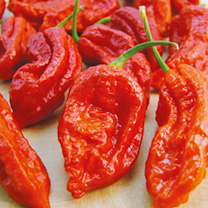How to Grow Chilli Peppers – A  Guide to Growing Chilli Peppers
Guide to Growing Chilli Peppers
Chilli Peppers
Chilli peppers are Capsicums. They grow well in a greenhouse or polytunnel, although they can be grown outside in a good summer in the milder South. They will also do well on a sunny window sill.
The heat in peppers and chillies is measured in Scoville Heat Units. Sweet peppers are rated zero but some of the hotter chilli varieties are rated at 1,000,000 SHU!
Sowing and Growing Chilli Peppers
- Sow during January, February and March, Maintain at 21ºC (70ºF) until seedlings germinate, ideally in a heated propagator , as some varieties need high temperatures to germinate reliably
- When large enough, prick out seedlings into 8 cm (3 inch) pots. Pot-on into 15 cm (6 inch) pots as they grow, before moving them to their final home.
- Chillies can be grown in the greenhouse/polytunnel border or in growbags or 20–25 cm (8–10 inch) pots. Try to maintain temperatures above 16C
- Some varieties grow as high as 90 cm (3 feet). The stems are brittle so the weight of fruits can break the plants if they are not tied to canes.
- Mist the plants with water once the flowers appear. This encourages the fruit to set and discourages red spidermite.
- When the flowers appear, feed as for tomatoes.
Harvesting Chilli
- Chillies come in many shapes and sizes, so it helps to know what size the ripe fruit should be for picking, especially if picking them at the green stage.
- Most varieties have fruit which is green when first formed. The colour changes to yellow or red over a few weeks on the plant.
Pests and Problems with Chilli Peppers
- The main pests are red spidermites and aphids. Misting the plants with water helps to deter spidermite or there are effective biological controls.
- Water regularly as Chilli peppers can suffer from blossom end rot.
Varieties of Chilli Peppers
You’ll find many varieties of chilli peppers to grow, of varying degrees of heat. The heat of chillies is caused by a chemical called capsaicin – the more of this the chilli contains, the hotter it will be.
- Some AGM (Award of Garden Merit) varieties to try are Apache, Demon Red, Fiesta and Filus Blue, a pretty plant with purple flowers and fruit.
- Habanero, Prairie Fire, and Thai Dragon are very hot.
- Hungarian Hot Wax is easy to grow and medium hot. It can be a used as a spicy alternative to sweet peppers.
Storing Chilli Peppers
- Chillies will keep for up to year dried. Tie or string the chillies in open bunches and hang them up in an airy, warm and dry place, they can also be frozen
- The heat of chillies is caused by a chemical called capsaicin – the more of this the chilli contains, the hotter it will be.
Be careful when preparing chilli peppers as the capsaicin will get onto your fingers. Wash your hands thoroughly afterwards, or wear rubber gloves while dealing with them. Don’t touch your face, especially your eyes or any sensitive areas of skin as the chemical will burn and be exceptionally painful.



